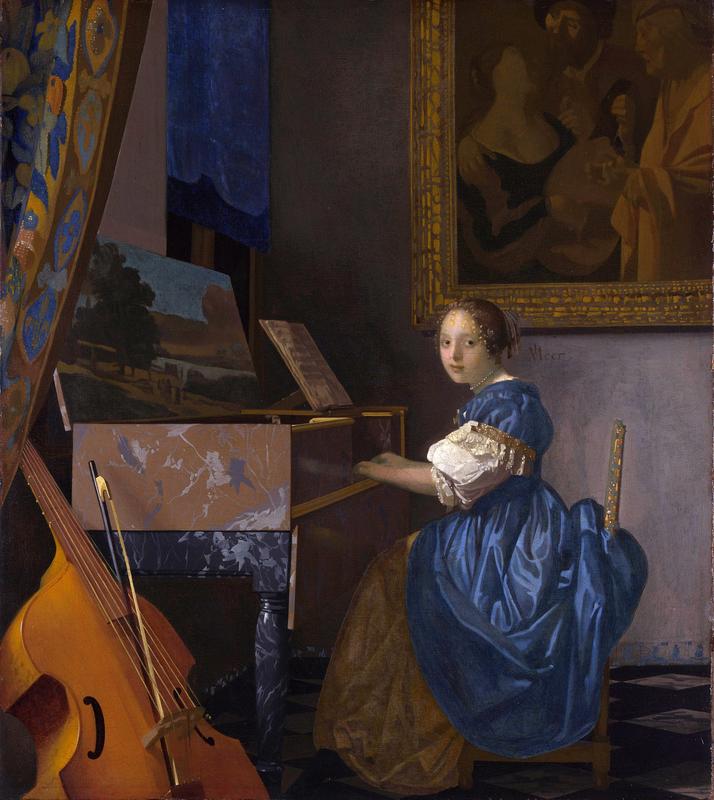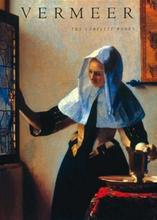More about A Young Woman Seated at a Virginal
- All
- Info
- Shop

Contributor
Unlike this aristocratic Lady Seated at a Virginal at the National Gallery, Vermeer's A Young Woman Seated at a Virginal of the Leiden Collection has received little attention from art historians because of extended controversy over its authenticity and a paucity of data on it.
To avoid confusion between the two works, we will note the name "woman" of the title of the image in the Leiden Gallery, and "lady" for the current painting. A virginal is a kind of harpsichord, which seems to have played a major role in the lives of Vermeer's subjects. Vermeer is one of the most difficult painters to understand, because his biography and the provenance of his works is so obscure. We do know, however, that although the Dutch merely tolerated Catholicism, Vermeer converted to the faith after marrying a Catholic woman, and may have been influenced by Caravaggio. In turn, a few centuries later, Dalí, also Catholic, named a painting after Vermeer.
One of the ways researchers can understand paintings like these is by searching for pendant pairs using forensic evidence. Artists compose pendant pairs of artworks for the purpose of displaying them together, as complements to each other, often on either side of a window or a fireplace. By placing a grid over a magnified image of an X-radiograph, Walter Liedtke and other researchers were able to count threads, giving them an estimate of the thread density of two Vermeer canvases, Young Woman Standing at a Virginal and this work, Lady Seated at a Virginal. Analyzing their work, C. Richard Johnson Jr. and W. A. Sethares write, "The average thread counts are similar, and the pattern of stripes in the thread-density weave maps match strikingly. This is consistent with the two canvases having originally been on the same bolt, thus suggesting a physical proximity that may mirror the intended pairing of the two works." This is almost literally "splitting hairs," but it gives us precious information about the elusive Vermeer.
Although he gained limited recognition locally during his life, writers and artists quickly forgot about him, and there was little research on him for over a century. In the 1860s, almost two centuries after Vermeer, the French critic Theophile Thore dubbed him "the Sphinx of Delft," his Dutch hometown. Thore exerted great energy in reconstructing a biography of Vermeer, based on tiny scraps of archival evidence.
Most writers are well aware of the embarrassing, ubiquitous danger of the passive voice. Unfortunately, people still tend to use the passive voice quite often, leaving great gaps of knowledge in the texts accompanying works of art. This is especially noticeable in cases where artists' work is obscure and people have forgotten it for generations. For instance, the Leiden Gallery's analysis of its own A Young Woman Seated at a Virginal, which is, as you recall, different from the painting you see here, claims that "this painting has only recently been reintegrated into Vermeer’s oeuvre after having been removed from the public’s eye for many years." Who removed it from the public's eye, and for what reason? It is likely that art historians, doubting its attribution to Vermeer, removed it from the public's eye, during one of the many debates regarding the work of Vermeer. The doubt regarding the authorship of A Young Woman Seated at a Virginal is partly due to the relatively awkward flow of the yellow shawl on the young woman's shoulders. "X-radiographs...have shown that beneath this shawl is a fully realized garment, with an intricately designed sleeve, that leads gracefully from the neck to the woman’s arms." The authors speculate that the shawl was added by another artist after the passing of Vermeer.
Sources
- Bailey, Anthony. "Very Still Life." The Economist, Apr. 19, 2001, https://www.economist.com/books-and-arts/2001/04/19/very-still-life.
- Hudson's Bay Company. "Royal.Charter of the Hudson's Bay Company." HBC, https://web.archive.org/web/20151007100328/http://hbcheritage.ca/hbcher….
- Johnson, Jr., C. Richard, and W. A. Sethares. “Canvas Weave Match Supports Designation of Vermeer’s Geographer and Astronomer as a Pendant Pair.” JHNA 9:1 (Winter 2017). Available at https://jhna.org/articles/canvas-weave-match-supports-designation-vermee
- Liedtke, Walter A., and Arthur K. Wheelock Jr. "Young Woman Seated at a Virginal." (JVe-100), In The Leiden Collection Catalogue, ed. Arthur K. Wheelock Jr. New York: The Leiden Gallery, 2017.
- Liedtke, Walter,Michiel C. Plomp, and Axel Rüger. Vermeer and the Delft school. New Haven: Yale University Press, 2001.
- Sotheby's. "Johannes Vermeer, Delft 1632 - 1675, A YOUNG WOMAN SEATED AT THE VIRGINALS." http://www.sothebys.com/en/auctions/ecatalogue/2004/old-master-painting….
- Sotheby's. Old Master Paintings, Part 1. London: Sotheby's, 2004.
Featured Content
Here is what Wikipedia says about Lady Seated at a Virginal
Lady Seated at a Virginal (Dutch: Zittende virginaalspeelster), also known as Young Woman Seated at a Virginal, is a genre painting created by the Dutch Golden Age painter Johannes Vermeer in about 1670–1672 and now in the National Gallery, London.
Check out the full Wikipedia article about Lady Seated at a Virginal













